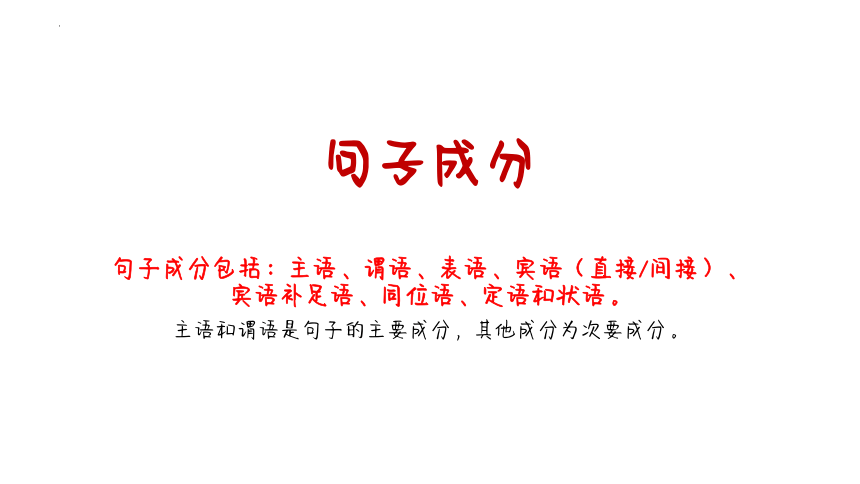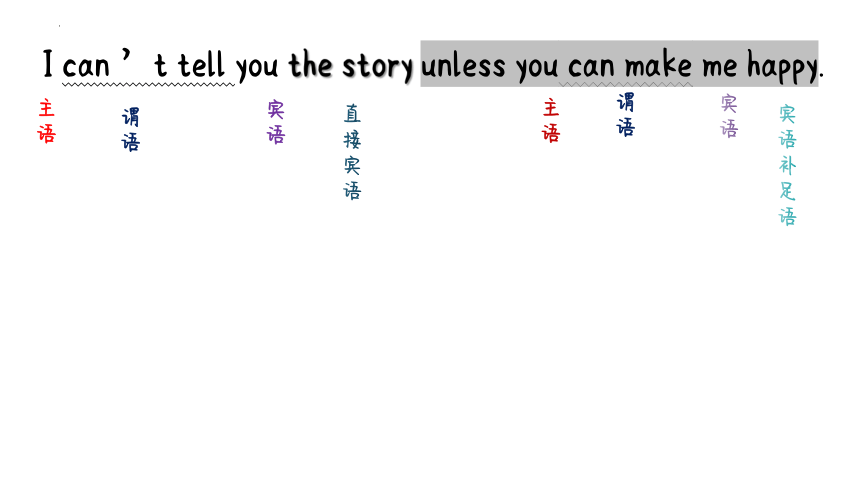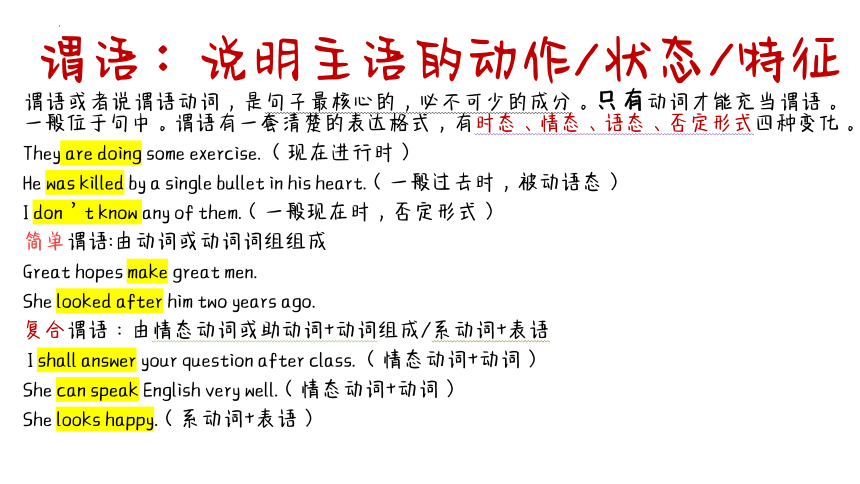-2023届高三英语复习:句子成分及例句 课件(16张PPT)
文档属性
| 名称 | -2023届高三英语复习:句子成分及例句 课件(16张PPT) |  | |
| 格式 | pptx | ||
| 文件大小 | 837.9KB | ||
| 资源类型 | 教案 | ||
| 版本资源 | 通用版 | ||
| 科目 | 英语 | ||
| 更新时间 | 2022-11-26 15:07:42 | ||
图片预览







文档简介
(共16张PPT)
句子成分
句子成分包括:主语、谓语、表语、宾语(直接/间接)、宾语补足语、同位语、定语和状语。
主语和谓语是句子的主要成分,其他成分为次要成分。
I saw the fat boy Tom crying on the train and he was cute.
主语
动作的发出者
谓语
动作
定语
修饰限定
宾语
动作的承受者
同位语
解释说明
补语
对宾语的补充说明
状语
动作发生的地点(时间)等
连接两个简单句
主语
系动词
联系前后
表语
说明主语的状态特征等
I can’t tell you the story unless you can make me happy.
主语
谓语
宾语
直接宾语
主语
谓语
宾语
宾语补足语
主语:什么人或什么事
主语是句子的核心成分之一。与其他成分相比,主语相对来说变化较少,位置通常谓语句首,倒装句时除外。主语由名词、代词、数词、名词短语或名词性从句充当,表示动作的施动者或者谈论的话题。
Mother made a big birthday cake on my birthday. (名词做主语)
He enjoys walking in the hills. (代词)
Four plus six is ten. (数词)
To work hard is important.(不定式)
Smoking is bad for the health.(动名词)
The young should respect the old. (名词化的形容词)
What she did is for your good. (名词性从句)
It is necessary to master a foreign language. (it作形式主语,真正的主语为后面的不定式)
谓语:说明主语的动作/状态/特征
谓语或者说谓语动词,是句子最核心的,必不可少的成分。只有动词才能充当谓语。一般位于句中。谓语有一套清楚的表达格式,有时态、情态、语态、否定形式四种变化。
They are doing some exercise. (现在进行时)
He was killed by a single bullet in his heart.(一般过去时,被动语态)
I don’t know any of them.(一般现在时,否定形式)
简单谓语:由动词或动词词组组成
Great hopes make great men.
She looked after him two years ago.
复合谓语:由情态动词或助动词+动词组成/系动词+表语
I shall answer your question after class. (情态动词+动词)
She can speak English very well.(情态动词+动词)
She looks happy.(系动词+表语)
宾语:动作的对象(及物动词或介词的宾语)
宾语就是动作的对象,是行为或动作的承受者。名词、代词、数词、不定式、动名词、从句均可做宾语。
Show your passport, please.(名词)
I saw her this morning.(代词)
If you add 5 to 3, you get 8. (数词)
She is learning to play the violin.(不定式)
He doesn’t like swimming.(动名词)
They have taken the wounded to the hospital.(名词化的形容词宾语)
I don’t know how to answer her. (疑问词+不定式)
He said that he would come. (宾语从句)
宾语分为直接宾语和间接宾语:有些及物动词,可以带两个宾语。一个指人,称为间接宾语,表示动作的方向或动作的目标;一个指物,称为直接宾语,表示动作的对象或结果,常由名词、代词、数词、不定式等充当。
Mother bought me a shirt yesterday.
间接宾语通常谓语直接宾语之前,但有时为了强调间接宾语,可用 “直接宾语+to/for +间接宾语”结构,把间接宾语后置。
Will you buy another dictionary for her
间接宾语
直接宾语
表语:说明主语的状态、特征、身份
(表语也称主语补足语)
说明主语“是什么”或“怎么样”,表述主语的特征、状态、身份,由名词、形容词、代词、数词、不定式、副词、介词短语或相当于名词或形容词的词或短语、句子等充当,和系动词一起构成谓语。常见的系动词有:
(1)表示状态的连系动词。
be, look, seem, appear, smell, taste, sound, keep, remain等;
(2)表示转变或结果的系动词。
become, get, grow, turn, go, come, prove等;
This kind of food tastes terrible.
These books are novels.
Her voice sounded familiar.
The future seems hopeful.
Your watch looks very nice.
She turned pale at the thought.
The room became crowded soon.
The well ran dry.
The food went bad.
定语:常修饰名词或代词,有前置定语和后置定语
用来修饰名词或代词,说明人或事物的品质和特征,作定于的除形容词外,还有代词、数词、名词、不定式、动名词、分词、介词短语或相当于形容词的词或短语、句子等。
注意,形容词修饰somebody, anything, nothing等不定代词时,要放在这些词的后面。else 作形容词修饰不定代词或疑问代词时,也要后置。
前置定语:用形容词、代词、数词、名词、动名词、分词作定语时通常放在被修饰词的前面
He is a cute boy.(形容词)
His father works in a steel work.(名词)
There are 54 students in our class.(数词)
He bought some sleeping pills.(动名词)
His spoken language is good.(过去分词)
后置定语:用副词、介词短语、不定式(短语)、分词短语、句子作定语时常放在被修饰词的后面
The girl in red is his sister.(介词短语)
We have a lot of work to do.(不定式)
The girl standing under the tree is his daughter.(分词短语)
Do you know the man who spoke just now (定语从句)
状语:常修饰动词或形容词、副词、全句
用来修饰动词、形容词或副词以及全句,副词、介词短语、分词、不定式、从句均可用来作状语。状语的位置很灵活,可置于句首、句中或句末。
1)副词
He immediately switched off the light.
2)介词短语
Fresh water was taken to this area by air.
3)不定式
I went there to see my old friend.
4)现在分词
Having arrived at a decision, they immediately set to work.
5)过去分词
She came in, followed by her husband.
6)从句(即状语从句)
I’ll come to your place when I am free.
7)独立主格
Everything prepared, we started our new journey.
8) 复合结构
With the task completed successfully, they went home happily.
状语种类如下:时间、地点、原因、结果、目的、条件、让步、方式、伴随情况
How about meeting again at six (时间状语)
He came late because of the rain.(原因状语)
I shall go there if it doesn’t rain. ( 条件状语)
Mr Smith lives on the third floor.(地点状语)
She put the eggs into the basket with great care.(方式状语)
She came in with a dictionary in her hand.(伴随状语)
He ran fast to catch the train .(目的状语)
He was so tired that he fell asleep immediately.(结果状语)
She works very hard though she is old.(让步状语)
I am taller than he is.(比较状语)
The river is very long.(程度状语)
宾语补足语
有些及物动词加了宾语后,还需要一个补足成分,才能使句意完整,这给补足成分就叫做宾语补足语。用来说明宾语的行为、状态 、特征、身份等,宾补由名词、形容词、不定式、数词、分词、介词短语等充当。
Do you smell something burning (现在分词)
He made himself known to them. (过去分词)
She asked me to lend her a hand. (不定式)
We elected him monitor. (名词)
I found her quite busy.(形容词)
I want him back.(副词)
同位语
用来说明或解释同一事物,位于名词或代词后面,说明它们的性质和情况。由名词、代词、动名词、数词、从句等充当。
We young people should respect the old.(名词)
He himself will do the experiment.(代词)
He is the oldest among them four.(数词)
He told me the news that our team won the game.(从句)
句子成分
句子成分包括:主语、谓语、表语、宾语(直接/间接)、宾语补足语、同位语、定语和状语。
主语和谓语是句子的主要成分,其他成分为次要成分。
I saw the fat boy Tom crying on the train and he was cute.
主语
动作的发出者
谓语
动作
定语
修饰限定
宾语
动作的承受者
同位语
解释说明
补语
对宾语的补充说明
状语
动作发生的地点(时间)等
连接两个简单句
主语
系动词
联系前后
表语
说明主语的状态特征等
I can’t tell you the story unless you can make me happy.
主语
谓语
宾语
直接宾语
主语
谓语
宾语
宾语补足语
主语:什么人或什么事
主语是句子的核心成分之一。与其他成分相比,主语相对来说变化较少,位置通常谓语句首,倒装句时除外。主语由名词、代词、数词、名词短语或名词性从句充当,表示动作的施动者或者谈论的话题。
Mother made a big birthday cake on my birthday. (名词做主语)
He enjoys walking in the hills. (代词)
Four plus six is ten. (数词)
To work hard is important.(不定式)
Smoking is bad for the health.(动名词)
The young should respect the old. (名词化的形容词)
What she did is for your good. (名词性从句)
It is necessary to master a foreign language. (it作形式主语,真正的主语为后面的不定式)
谓语:说明主语的动作/状态/特征
谓语或者说谓语动词,是句子最核心的,必不可少的成分。只有动词才能充当谓语。一般位于句中。谓语有一套清楚的表达格式,有时态、情态、语态、否定形式四种变化。
They are doing some exercise. (现在进行时)
He was killed by a single bullet in his heart.(一般过去时,被动语态)
I don’t know any of them.(一般现在时,否定形式)
简单谓语:由动词或动词词组组成
Great hopes make great men.
She looked after him two years ago.
复合谓语:由情态动词或助动词+动词组成/系动词+表语
I shall answer your question after class. (情态动词+动词)
She can speak English very well.(情态动词+动词)
She looks happy.(系动词+表语)
宾语:动作的对象(及物动词或介词的宾语)
宾语就是动作的对象,是行为或动作的承受者。名词、代词、数词、不定式、动名词、从句均可做宾语。
Show your passport, please.(名词)
I saw her this morning.(代词)
If you add 5 to 3, you get 8. (数词)
She is learning to play the violin.(不定式)
He doesn’t like swimming.(动名词)
They have taken the wounded to the hospital.(名词化的形容词宾语)
I don’t know how to answer her. (疑问词+不定式)
He said that he would come. (宾语从句)
宾语分为直接宾语和间接宾语:有些及物动词,可以带两个宾语。一个指人,称为间接宾语,表示动作的方向或动作的目标;一个指物,称为直接宾语,表示动作的对象或结果,常由名词、代词、数词、不定式等充当。
Mother bought me a shirt yesterday.
间接宾语通常谓语直接宾语之前,但有时为了强调间接宾语,可用 “直接宾语+to/for +间接宾语”结构,把间接宾语后置。
Will you buy another dictionary for her
间接宾语
直接宾语
表语:说明主语的状态、特征、身份
(表语也称主语补足语)
说明主语“是什么”或“怎么样”,表述主语的特征、状态、身份,由名词、形容词、代词、数词、不定式、副词、介词短语或相当于名词或形容词的词或短语、句子等充当,和系动词一起构成谓语。常见的系动词有:
(1)表示状态的连系动词。
be, look, seem, appear, smell, taste, sound, keep, remain等;
(2)表示转变或结果的系动词。
become, get, grow, turn, go, come, prove等;
This kind of food tastes terrible.
These books are novels.
Her voice sounded familiar.
The future seems hopeful.
Your watch looks very nice.
She turned pale at the thought.
The room became crowded soon.
The well ran dry.
The food went bad.
定语:常修饰名词或代词,有前置定语和后置定语
用来修饰名词或代词,说明人或事物的品质和特征,作定于的除形容词外,还有代词、数词、名词、不定式、动名词、分词、介词短语或相当于形容词的词或短语、句子等。
注意,形容词修饰somebody, anything, nothing等不定代词时,要放在这些词的后面。else 作形容词修饰不定代词或疑问代词时,也要后置。
前置定语:用形容词、代词、数词、名词、动名词、分词作定语时通常放在被修饰词的前面
He is a cute boy.(形容词)
His father works in a steel work.(名词)
There are 54 students in our class.(数词)
He bought some sleeping pills.(动名词)
His spoken language is good.(过去分词)
后置定语:用副词、介词短语、不定式(短语)、分词短语、句子作定语时常放在被修饰词的后面
The girl in red is his sister.(介词短语)
We have a lot of work to do.(不定式)
The girl standing under the tree is his daughter.(分词短语)
Do you know the man who spoke just now (定语从句)
状语:常修饰动词或形容词、副词、全句
用来修饰动词、形容词或副词以及全句,副词、介词短语、分词、不定式、从句均可用来作状语。状语的位置很灵活,可置于句首、句中或句末。
1)副词
He immediately switched off the light.
2)介词短语
Fresh water was taken to this area by air.
3)不定式
I went there to see my old friend.
4)现在分词
Having arrived at a decision, they immediately set to work.
5)过去分词
She came in, followed by her husband.
6)从句(即状语从句)
I’ll come to your place when I am free.
7)独立主格
Everything prepared, we started our new journey.
8) 复合结构
With the task completed successfully, they went home happily.
状语种类如下:时间、地点、原因、结果、目的、条件、让步、方式、伴随情况
How about meeting again at six (时间状语)
He came late because of the rain.(原因状语)
I shall go there if it doesn’t rain. ( 条件状语)
Mr Smith lives on the third floor.(地点状语)
She put the eggs into the basket with great care.(方式状语)
She came in with a dictionary in her hand.(伴随状语)
He ran fast to catch the train .(目的状语)
He was so tired that he fell asleep immediately.(结果状语)
She works very hard though she is old.(让步状语)
I am taller than he is.(比较状语)
The river is very long.(程度状语)
宾语补足语
有些及物动词加了宾语后,还需要一个补足成分,才能使句意完整,这给补足成分就叫做宾语补足语。用来说明宾语的行为、状态 、特征、身份等,宾补由名词、形容词、不定式、数词、分词、介词短语等充当。
Do you smell something burning (现在分词)
He made himself known to them. (过去分词)
She asked me to lend her a hand. (不定式)
We elected him monitor. (名词)
I found her quite busy.(形容词)
I want him back.(副词)
同位语
用来说明或解释同一事物,位于名词或代词后面,说明它们的性质和情况。由名词、代词、动名词、数词、从句等充当。
We young people should respect the old.(名词)
He himself will do the experiment.(代词)
He is the oldest among them four.(数词)
He told me the news that our team won the game.(从句)
